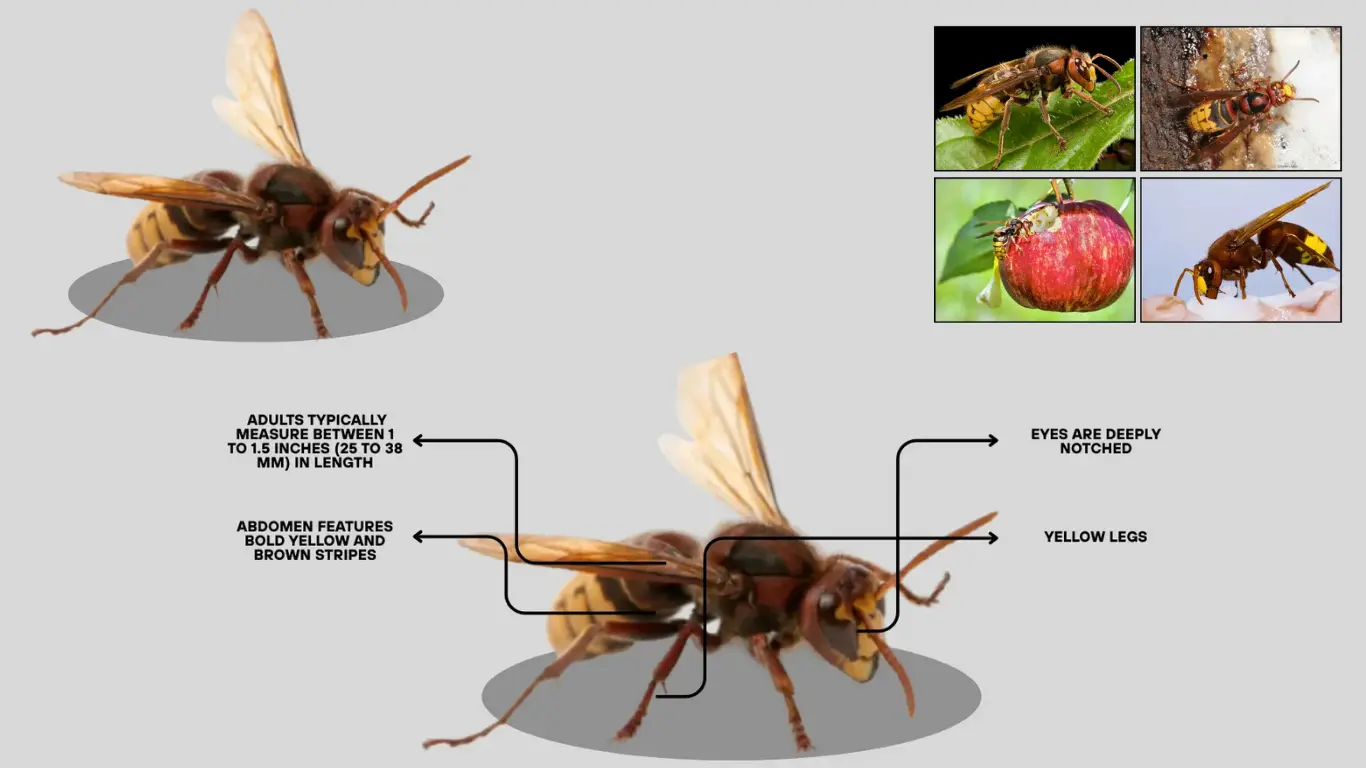The European hornet (Vespa crabro) is a large, striking wasp known for its loud buzz, powerful sting, and hidden nests in trees or buildings. Though often feared, it plays a role in pest control. This guide covers everything from its size and sting to nest behavior and identification with pictures.
Identification and Appearance
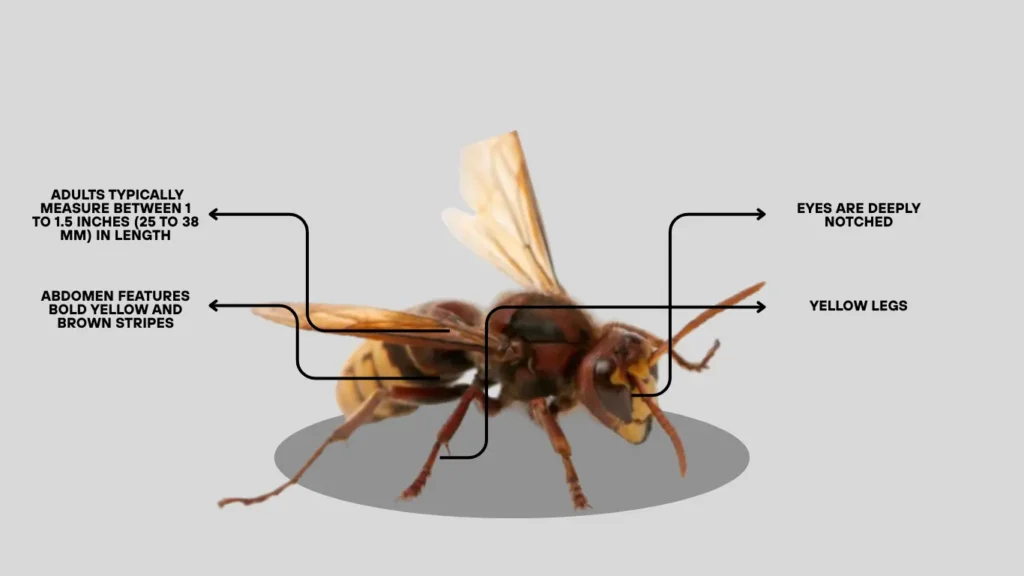
The European hornet (Vespa crabro) is one of the largest wasps you’ll encounter in Europe and North America. Adults typically measure between 1 to 1.5 inches (25 to 38 mm) in length, making them significantly larger than yellow jackets and paper wasps. Queens are even bigger, sometimes exceeding 1.6 inches (40 mm).
Their distinct appearance sets them apart from other hornet species. The head and thorax are reddish-brown, while the abdomen features bold yellow and brown stripes. Their large, strong wings give off a deep buzzing sound when in flight, often heard before they’re seen. The eyes are deeply notched, and they have a prominent pair of dark antennae.
One key identifier is their yellow legs, which contrast with their darker body. Unlike some wasps that move erratically, European hornets often fly in smooth, direct paths and are most active during dusk and nighttime hours. This nocturnal behavior is unusual among wasps and makes them more noticeable near outdoor lights.
Pictures or sightings often capture their robust and intimidating presence, but it’s important not to confuse them with the Asian giant hornet or the cicada killer wasp, which differ in pattern, head shape, and behavior.
Queen, Male & Worker Differences
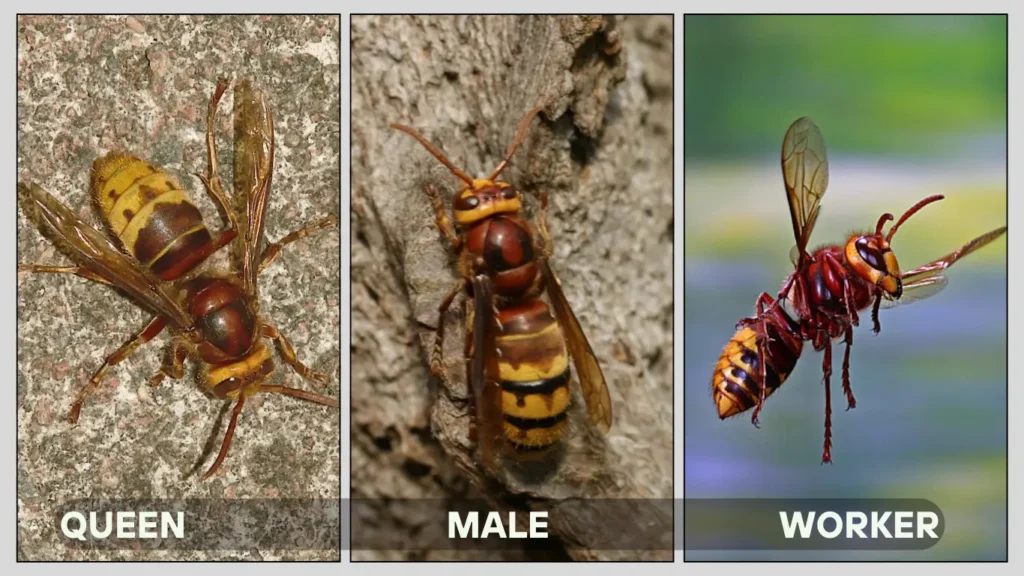
European hornets live in social colonies made up of three castes: queen, workers, and males (drones). While they share many physical traits, each type has specific characteristics and roles that set them apart.
The queen is the reproductive leader of the colony. She is larger than the others and typically the first to emerge in spring. Workers, all female, do the bulk of the labor: foraging, defending the nest, and caring for larvae. Males appear later in the season and exist solely to mate with new queens before dying off.
Here’s a clear comparison:
| Feature | Queen | Worker | Male (Drone) |
| Size | Largest (up to 40 mm) | Medium (25–30 mm) | Medium (similar to workers) |
| Role | Lays eggs | Forages, defends, feeds larvae | Mates with queen |
| Wings | Long and strong | Shorter than queen’s | Similar to workers |
| Antennae | Slightly curved | Straight | Noticeably longer, curved |
| Stinger | Yes | Yes | No (can’t sting) |
| Season seen | Spring to fall | Late spring to fall | Late summer to fall |
| Lifespan | Up to 1 year (hibernates) | A few weeks to months | A few weeks |
Recognizing the queen’s size and presence of a stinger can help you determine if a nest is in early or late stages. If you spot multiple males, it’s likely the colony is nearing the end of its life cycle for the season.
Behavior and Activity
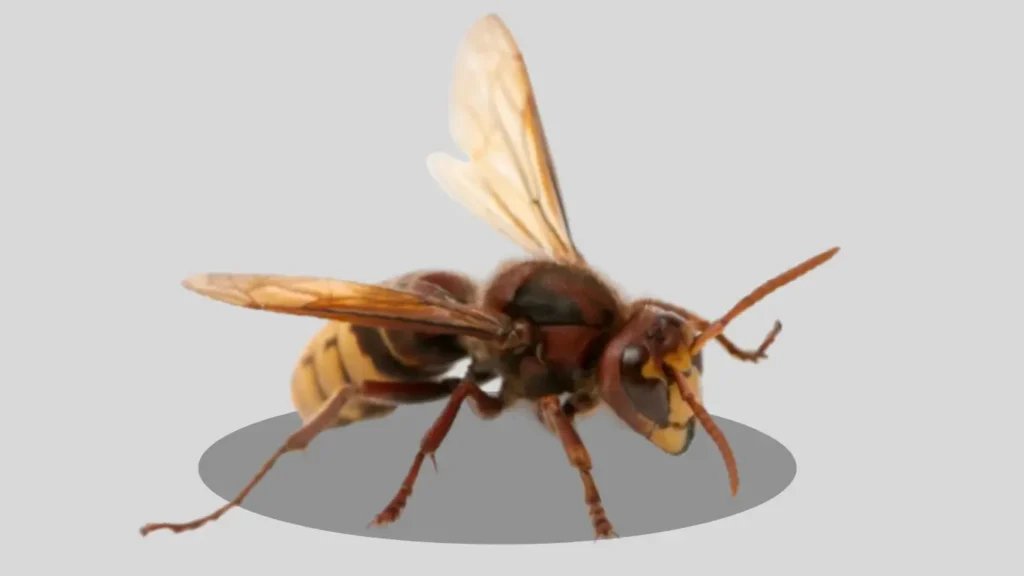
European hornets exhibit distinct behavioral traits compared to other wasps and hornets, especially in how they move, when they’re active, and how they respond to threats.
Unlike most wasps that are active only during daylight hours, European hornets are also nocturnal. They often fly toward porch lights, streetlamps, and windows at night, which can startle homeowners. Their ability to forage and defend their nest in darkness sets them apart from other species.
Despite their intimidating appearance and loud buzz, European hornets are generally not aggressive unless provoked. They usually go about their tasks—like hunting insects or collecting tree sap—without interfering with humans. However, they will defend their nest fiercely if it’s disturbed. Multiple hornets may attack in swarms, delivering painful stings.
Their flight behavior is also unique. European hornets fly in smooth, steady paths rather than darting around erratically like yellow jackets. They’re capable of long-distance flights when foraging, and they often follow the same route between food sources and their nest.
When threatened, they may issue warning buzzes or head-butting behaviors before stinging—signs that should be taken seriously if you’re near a nest.
Diet and Prey
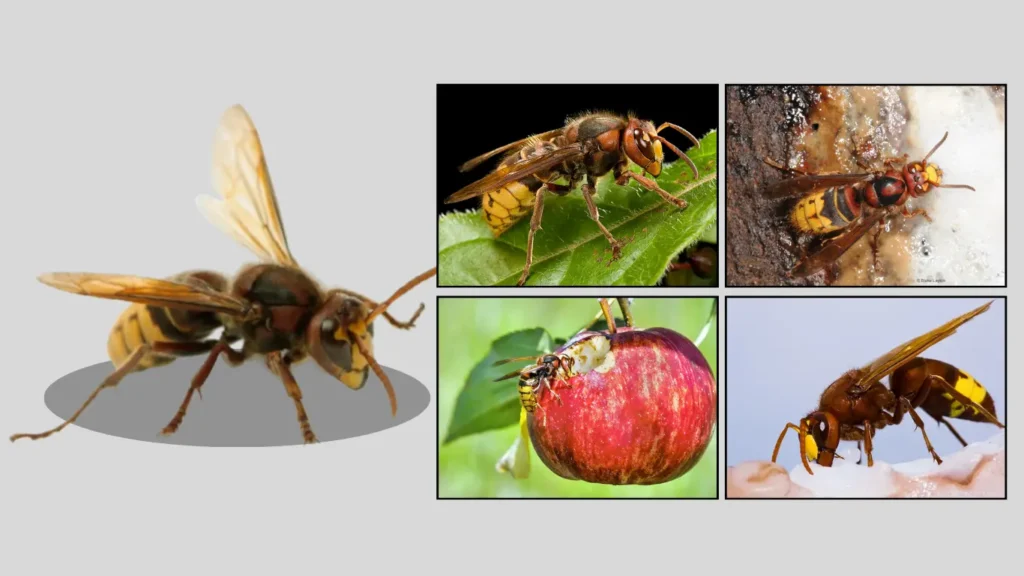
European hornets are predatory insects with a varied diet that plays an important role in maintaining ecological balance. As carnivores and scavengers, they help control populations of other insects, but their feeding behavior can sometimes cause problems for humans.
Their primary food sources include:
- Insects: They hunt and feed on grasshoppers, flies, crickets, moths, and other wasps. European hornets chew these insects into a pulp to feed their larvae, especially during the active breeding season.
- Tree sap: They frequently feed on sap from trees such as oak and ash, often leaving visible marks or damage on bark.
- Overripe fruits: These hornets are attracted to fermenting fruits like apples, pears, and grapes, which can bring them into conflict with farmers and gardeners.
- Sugary substances: Just like other wasps, they seek out sweet drinks, fallen fruit, and even pet food in outdoor areas, especially during late summer and early fall when natural food sources decline.
Interestingly, while the larvae feed on protein, adult hornets prefer carbohydrates. The adults feed their young chewed-up insect matter and, in return, receive a sugary secretion from the larvae—a mutual exchange common in social wasps.
This dual role as both pest controllers and occasional nuisances means they are beneficial in nature but can become unwelcome guests near homes, orchards, and picnic areas.
Nesting Structure
European hornets are skilled nest builders, creating large, paper-like nests that can house hundreds of individuals. Their nests are made by chewing wood fibers into a pulpy material, which they use to form layered, comb-like chambers.
Unlike many wasps that build exposed nests under eaves or tree branches, European hornets prefer more hidden, enclosed spaces. You’re most likely to find their nests in:
- Hollow trees
- Wall cavities
- Attics or sheds
- Barn rafters or abandoned structures
The exterior of the nest is tan or gray, with a rough, layered texture that often resembles old paper. When located outdoors, the nest entrance is typically a single hole near the bottom. In hollow tree nests, you may only see hornets coming and going without the nest itself being visible.
Nests grow rapidly throughout the summer. By late season, some can reach the size of a basketball, especially if conditions are ideal and the colony is undisturbed. Unlike bald-faced hornets, European hornets usually do not hang their nests from branches in full view—they prefer privacy and shelter.
Due to their discreet placement and aggressive nest defense, European hornet nests can be dangerous to discover accidentally, especially during yard work, tree trimming, or construction.
Nesting Habits and Lifecycle
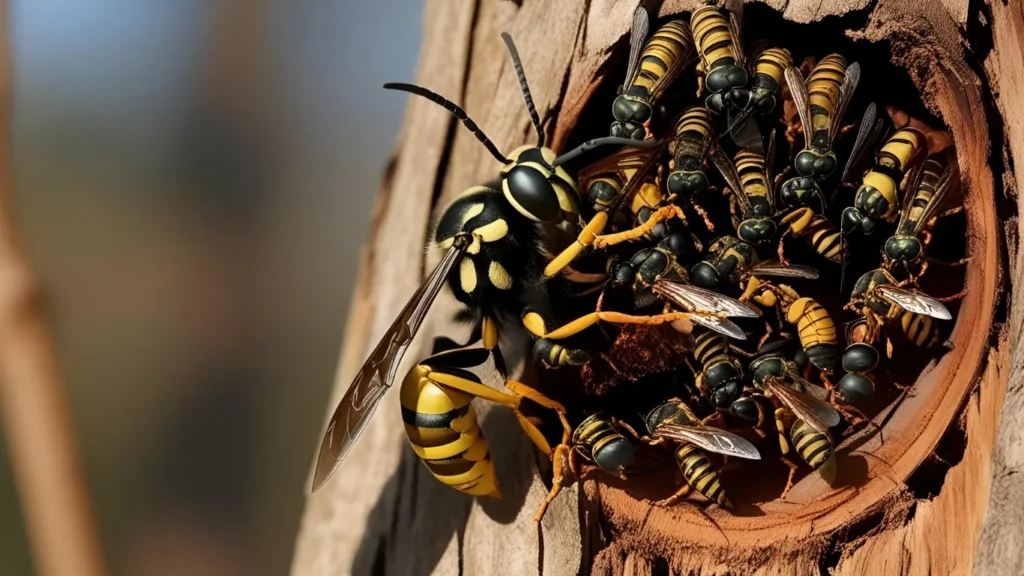
The lifecycle of a European hornet colony follows a seasonal pattern, beginning with a single queen and expanding into a full-fledged colony by late summer.
In early spring, a fertilized queen emerges from hibernation and seeks a suitable nesting site—typically a hollow tree, attic, or wall void. Once settled, she starts building the first few cells of the nest and lays eggs. These initial eggs hatch into female workers, who soon take over the duties of foraging, nest expansion, and brood care.
From that point on, the queen focuses solely on laying eggs. The nest grows steadily through spring and summer, with the population increasing to 200–400 hornets by late summer, though large nests can house even more.
In late summer to early fall, the colony produces new queens and males (drones). These males leave the nest to mate with virgin queens from other colonies. After mating, the males die, and the new queens seek shelter to hibernate through the winter.
As temperatures drop, the colony starts to die off, including the founding queen and all workers. Only the newly mated queens survive, hidden away in protected spots like leaf litter or under bark. The nest is never reused—each year, a new queen begins the cycle again in a new location.
This lifecycle makes it easy to time removal or prevention efforts—early spring is best, before the colony has a chance to grow large or aggressive.
Habitat and Environment
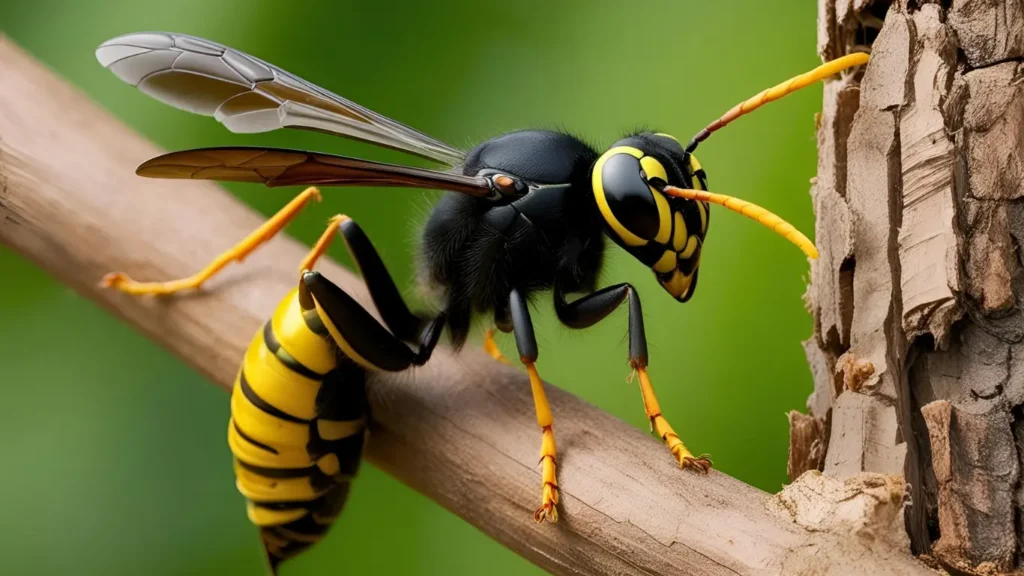
European hornets thrive in a wide range of environments but show a strong preference for wooded areas, rural zones, and suburban neighborhoods with access to trees and sheltered structures. Originally native to Europe and parts of Asia, they’ve successfully expanded their range into North America, particularly in the eastern United States.
Their ideal habitat includes:
- Forests and wooded landscapes – They often nest in hollow tree trunks, dead stumps, or logs.
- Urban and suburban areas – Attics, wall voids, sheds, barns, and eaves offer suitable shelter.
- Orchards and gardens – These areas provide easy access to fruit, tree sap, and insect prey.
European hornets are adaptable but tend to avoid wide open, treeless spaces unless there are nearby buildings or wooded patches. They also prefer quiet, undisturbed locations for nesting and are less likely to thrive in areas with frequent foot traffic or heavy machinery.
Their presence in a region is often seasonal, with most activity observed from late spring through early fall. Warm, humid climates allow colonies to grow larger, while cooler regions typically see smaller nests and shorter activity windows.
They’re most active in eastern and central U.S. states, but sightings are expanding. Homeowners in wooded neighborhoods or near agricultural zones should be especially alert.
Sightings in the USA
European hornets (Vespa crabro) were first introduced to North America in the mid-1800s and have since established strong populations across the eastern and central United States. Their spread continues as they adapt to new environments.
Here are some of the most common states where European hornets are regularly reported:
- Pennsylvania – One of the most active regions, with frequent sightings in rural and suburban areas.
- Maryland – Often found in wooded neighborhoods and near farmlands.
- Virginia – A well-documented hotspot with reports of large nests in tree cavities and structures.
- North Carolina – Active through spring to fall, especially near wooded trails and homes.
- Ohio – Sightings have increased in recent years, especially in forested residential zones.
- New Jersey – Nests are commonly found in wall voids and garden sheds.
- New York – Urban sightings are rare, but they’re common in outer suburbs with tree cover.
- Tennessee & West Virginia – Homeowners often report tree damage and night activity around porch lights.
- Florida – Populations exist but are limited due to heat and competition with other wasps.
- Texas – Rare but slowly appearing in wooded northern and eastern parts of the state.
In these regions, hornets are most active between May and October, with peak nest size and aggression levels in late summer. Homeowners should be especially cautious during this time and avoid disturbing areas where hornets are frequently seen entering and exiting.
As they continue to expand westward, monitoring and awareness are key to managing their impact on homes and local ecosystems.
Sting and Reactions
The sting of a European hornet is one of the more painful among wasp and hornet species, primarily due to its large size and deep stinger penetration. Although not as venomous as the Asian giant hornet, its sting can still cause significant pain and swelling, especially if the person is stung multiple times or has an allergic reaction.
What Happens During a Sting:
When a European hornet stings, it injects venom that causes an immediate burning or stabbing pain, followed by redness, warmth, and localized swelling. Unlike bees, hornets can sting multiple times because their stinger doesn’t get stuck in the skin.
Common Symptoms After a Sting:
- Sharp, intense pain at the sting site
- Redness and raised welt
- Swelling that may extend several inches around the area
- Itching or warmth around the sting
Serious Reactions (Seek Medical Attention If You Experience These):
- Widespread hives or rash
- Difficulty breathing or wheezing
- Swelling of the face, lips, or throat
- Dizziness or rapid heartbeat
- Anaphylaxis, a life-threatening allergic reaction (rare, but possible)
Treatment and First Aid:
- Clean the sting site with soap and water to prevent infection
- Apply a cold compress to reduce swelling and pain
- Take antihistamines (e.g., diphenhydramine/Benadryl) to reduce itching and inflammation
- Use over-the-counter pain relievers like ibuprofen or acetaminophen
- Hydrocortisone cream may help with localized itch or redness
If a person is stung multiple times, especially near the head or neck, or shows signs of an allergic reaction, seek emergency medical help immediately.
Dangers and Damage
Although European hornets are not typically aggressive toward humans without provocation, they can still pose serious risks—both physically and structurally—when they build nests near homes or public areas.
Structural Damage
European hornets often chew wood fibers from fences, decks, sheds, and even house siding to create their nests. This habit can lead to:
- Cosmetic damage on wooden surfaces
- Bark stripping from ornamental or fruit trees
- Noticeable scarring on fences, window frames, and garden furniture
When nesting inside wall voids, attics, or barns, they may also cause:
- Staining from waste or decaying insects brought into the nest
- Noise disturbances from buzzing and movement in walls or ceilings
Threat to Trees
Hornets feed on sap from live trees, especially oaks, maples, and ash. In doing so, they often chew through bark to access the sap, which:
- Weakens tree limbs
- Leaves visible damage and scars
- Increases the risk of fungal infections or other pest infestations
Threat to People and Pets
When a nest is located close to human activity, the hornets may:
- Defend aggressively if they perceive movement or vibration near the nest
- Attack in numbers when disturbed
- Pose danger to pets who unknowingly approach or disturb nests
Children and pets are especially at risk since they may not recognize warning signs like increased hornet activity or buzzing. Accidental encounters during lawn care, pruning, or building repairs are also common.
For these reasons, even a single visible hornet should prompt caution and possible inspection for nearby nesting sites.
Removal Methods
Removing a European hornet nest is a task that should be approached with extreme caution, as these hornets will aggressively defend their colony when disturbed. Proper timing, protective gear, and sometimes professional help are necessary to avoid stings and escalation.
When to Remove a Nest
- Early spring: Best time to act, when the colony is small and only the queen is active.
- Evening or nighttime: Hornets are less active after dusk, making it safer to inspect or treat the area.
- Before late summer: As the colony grows, removal becomes more dangerous and complicated.
DIY Removal: Only for Small or Early-Stage Nests
If the nest is visible and accessible (e.g., on a tree branch or fence post), and the colony is still small, some people attempt DIY removal using:
- Hornet spray insecticides labeled for aerial nests
- A long-range spray (10–20 feet distance) applied at dusk or night
- Wearing thick clothing and a face shield for protection
- Carefully retreating after application and repeating the process the next night if needed
Do not attempt DIY removal if:
- The nest is inside a wall void, attic, or structure
- You’re allergic to stings
- The nest is large and heavily active
- You are unsure of the exact hornet species
Professional Extermination
For large nests or indoor infestations, it is highly recommended to contact a licensed pest control service. They have:
- Protective suits and advanced tools
- The knowledge to locate hidden nests
- The ability to safely remove or neutralize colonies without risk to people or pets
In some areas, local governments or universities (e.g., Penn State Extension) provide advice or referrals for managing hornet nests, especially when located near schools or public spaces.
Post-Removal Prevention
- Seal entry points in siding, roof gaps, and attics
- Trim overhanging branches that lead to buildings
- Remove old stumps or hollow logs from yards
- Avoid leaving out uncovered sweet foods or pet dishes
Eliminating attractants and securing your home will greatly reduce the chance of future infestations.
7 Interesting Facts About European Hornets
- They are the only true hornet species established in the U.S.
European hornets are not native to North America but have successfully adapted since their introduction in the 1800s. - European hornets are active at night.
Unlike most wasps, they are nocturnal and often fly toward outdoor lights, making them more noticeable after sunset. - Their sting is painful but rarely life-threatening.
While their sting can cause intense localized pain, severe reactions are uncommon unless the person is allergic. - They chew wood to build nests.
Hornets strip bark and chew wood from trees and structures to make their distinctive papery nests. - They help control insect populations.
As predators, they feed on flies, grasshoppers, and other pest insects, playing a beneficial role in the ecosystem. - They do not reuse old nests.
Each year, a new queen builds a fresh nest. Abandoned nests are not reoccupied. - Their colonies die out in winter.
Only the fertilized queens survive by hibernating. The rest of the colony, including the original queen, dies off by late fall.
Comparison with Other Hornets & Wasps
European hornets are often confused with other large, stinging insects due to their similar size and coloring. However, they differ in behavior, aggression, and ecological role. Comparing them side-by-side with species like the Asian giant hornet, yellow jacket, cicada killer wasp, and bald-faced hornet helps clarify their identity and threat level.
Here’s a comparison table:
| Feature | European Hornet | Asian Giant Hornet | Yellow Jacket | Cicada Killer Wasp | Bald-Faced Hornet |
| Size | 1–1.5 in (25–38 mm) | Up to 2 in (50 mm) | 0.5 in (13 mm) | 1.5–2 in (38–50 mm) | 0.75 in (19 mm) |
| Color | Reddish-brown with yellow | Orange head, dark body | Bright yellow and black | Reddish with yellow/black | Black with white markings |
| Aggression Level | Moderate if provoked | High, aggressive | Very aggressive | Low | Aggressive near nest |
| Flight Time | Day & Night (Nocturnal) | Daytime only | Daytime only | Daytime only | Daytime only |
| Nest Location | Hidden: walls, trees | Ground, tree hollows | Ground, walls | Burrows in soil | Trees, shrubs, structures |
| Sting Risk to Humans | Medium | High (dangerous in swarms) | High | Low | Medium |
| Ecosystem Role | Predatory, controls pests | Predatory, can threaten bees | Opportunistic scavenger | Targets cicadas only | Predatory |
Similar or Confused Species
European hornets are frequently mistaken for other large wasps or hornet-like insects due to overlapping sizes, colors, and behaviors. Misidentification can lead to unnecessary panic or improper pest control responses. Here are some of the most commonly confused species and how they differ:
1. Bald-Faced Hornet
- Appearance: Black body with striking white facial markings and white bands on the abdomen
- Size: Smaller, about 0.75 inches (19 mm)
- Key Difference: Nests are often aerial and visible, hanging from tree branches or eaves
2. Cicada Killer Wasp
- Appearance: Large and wasp-like with reddish wings and black/yellow striped abdomen
- Size: Can reach up to 2 inches (50 mm), often larger than European hornets
- Key Difference: Solitary burrowers in the ground; not aggressive to humans
3. Asian Giant Hornet (a.k.a. “Murder Hornet”)
- Appearance: Massive size with an orange head and dark body
- Size: Up to 2 inches (50 mm)
- Key Difference: Not established in most regions where European hornets are found; extremely aggressive and rarely mistaken at close range
4. Yellow Jacket
- Appearance: Small, compact body with bright yellow and black stripes
- Size: About 0.5 inches (13 mm)
- Key Difference: Smaller and much more aggressive; nests often found underground or in wall voids
5. European Paper Wasp
- Appearance: Slim, wasp-like body with black and yellow coloring
- Size: Around 0.5–0.75 inches (12–19 mm)
- Key Difference: Much thinner and more delicate in appearance; often seen building small umbrella-shaped nests
Being able to distinguish these species is important for proper management and safety. European hornets tend to be less aggressive than yellow jackets and larger than most native wasps, but their nocturnal activity and wood-chewing habits can make them more noticeable in domestic settings.
Summary
European hornets are large, nocturnal insects that can be both beneficial and hazardous. While they help control pest populations, their nests near homes can pose risks due to their aggressive defense behavior. Identifying them accurately and addressing nests early is essential for safety. Professional removal is strongly advised for large or hidden infestations.

